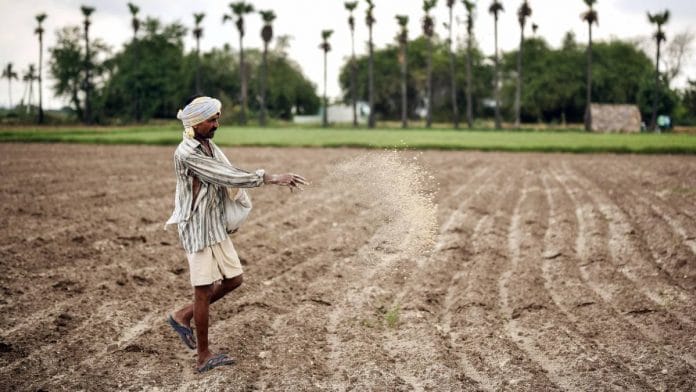New Delhi: Some of the states that have topped the parameters for farm productivity and agricultural growth in the Niti Aayog Sustainable Development Goals (SDG) India Index 2021 have also fared the worst on two other key yardsticks: Use of fertilisers harmful to human health, and groundwater depletion.
These include Punjab and Haryana, which are among India’s leading producers of wheat and rice, the benchmark foodgrains for the index.
Their performance suggests the states are making progress in pushing the growth of agriculture, but probably at the expense of the environment. Both states have an open-procurement policy that sees the states purchase at MSP all the wheat and rice brought by farmers for the central pool.
The Niti Aayog index seeks to track India’s performance with regard to the SDGs set by the United Nations, with 2030 as the deadline to achieve them. The latest edition of the report, which outlines the performance of states and union territories against different parameters, was released last week. It covers 17 SDGs and 169 targets.
The four parameters taken into account for this report are agricultural productivity of foodgrains (in kilogram/hectare) and gross value added (GVA) in agriculture (in lakh/worker) on the one hand, and fertiliser and groundwater consumption on the other.
The first two come under the second SDG, which aims to end all forms of hunger and malnutrition by 2030 and calls for promoting sustainable agriculture, supporting small-scale farmers, and equal access to land, technology, and markets. Fertiliser consumption comes under the 12th SDG, which aims at resource efficiency, green economies, and sustainable infrastructure by focusing on reducing degradation and pollution and minimising waste.
Groundwater is a part of the sixth SDG, which deals with clean water and sanitation.
Also Read: What is nano urea? India’s ‘21st century’ product aiming to revolutionise world agriculture
Doing well
The agricultural productivity index is calculated on the basis of annual rice and wheat production by kg/Ha. The goal under this index is to double the productivity of rice and wheat (from base year 2015-16) to 5,322 kg/Ha by 2030.
Punjab and Haryana, which have topped the index, also stand closest to this target. While Punjab recorded rice and wheat productivity at 4,693.24 kg/Ha in 2018-19, Haryana’s stood at 4,272.42 kg/Ha.
Other states leading in this index are Andhra Pradesh (3729.47kg/ha), Tamil Nadu (3561.89kg/ha), Telangana (3448.32 kg/ha), Rajasthan (3423.23 kg/ha), and Uttar Pradesh (3158.46kg/ha). The national wheat and rice productivity in the report stands at 2,995 kg/ha.
Punjab and Haryana are also the leading states in the GVA index, which deals with agricultural growth and income.
GVA provides the rupee value for the amount of goods and services produced in agriculture after deducting the cost of inputs and raw materials that have gone into their production.
While the national target of GVA in agriculture per worker is set at Rs 1.22 lakh, Punjab and Haryana recorded Rs 2.57 lakh and Rs 1.99 lakh, respectively. The current national agriculture GVA stands at Rs 0.71 lakh/worker, according to the report.
This performance of Punjab and Haryana in agricultural productivity and income can be attributed to the open-ended procurement of wheat and rice from these states by the central government at MSP. Both these states have been the leading contributors to the central pool of buffer foodgrains stock in previous years, as also in the latest kharif and rabi procurement seasons.
However, this incentive cycle of assured wheat and rice procurement has ushered in an unprecedented crisis, making the states the worst performers in the fertiliser consumption index.
Where they fare poorly
According to the Niti Aayog index, the use of nitrogenous fertilisers should not exceed 57 per cent. However, while the share of these fertilisers is 78.89 per cent in Punjab, it is 75.84 per cent in Haryana. The consumption of nitrogenous fertiliser in these states is far higher than the national average of 64.39 per cent.
In 2018, fertiliser consumption in Punjab reportedly stood at 232 kg/ha, against the national average of 133 kg/ha. The use of NPK, a major farm fertiliser, stood at 1.8 million tonnes in 2018-19, as against 1.7 million tonnes in 2007-08.
Rajasthan and Uttar Pradesh, which also enjoy high foodgrain productivity, have also fared poorly in nitrogen fertiliser use, recording shares of 70.63 per cent and 73.72 per cent, respectively.
While nitrogenous fertilisers have been linked with bumper agricultural productivity, whose upshots include income growth, it is also known to have severe environmental and health repercussions.
According to studies, excessive use of nitrogen fertilisers can cause thyroid conditions, various kinds of human cancers, neural defects, and diabetes, apart from resulting in environmental pollution affecting climate and groundwater.
Investigations carried out by the Union Ministry of Agriculture over five decades have linked persistent use of nitrogenous fertilisers alone with damaging effects on soil health and crop productivity, as well as deficiencies of major and micronutrients. The UN has said that nitrogen additions to the soil, in the form of fertilisers, reinforce the greenhouse effect, causing global warming and climate change-related fallouts.
The assured purchase of wheat and rice, both of which are water-guzzling crops, has also proved costly in terms of the availability of safe drinking groundwater.
Under the index, the safe limit of groundwater withdrawal is 70 per cent of the quantity available. However, Punjab, the worst performer on this count, recorded a figure 165.8 per cent, with Haryana notching 136.9 per cent. This means they are drawing groundwater at a faster pace than it is recharged.
Also Read: Indian agriculture — 6 tough realities, 5 dangerous myths and some solutions






